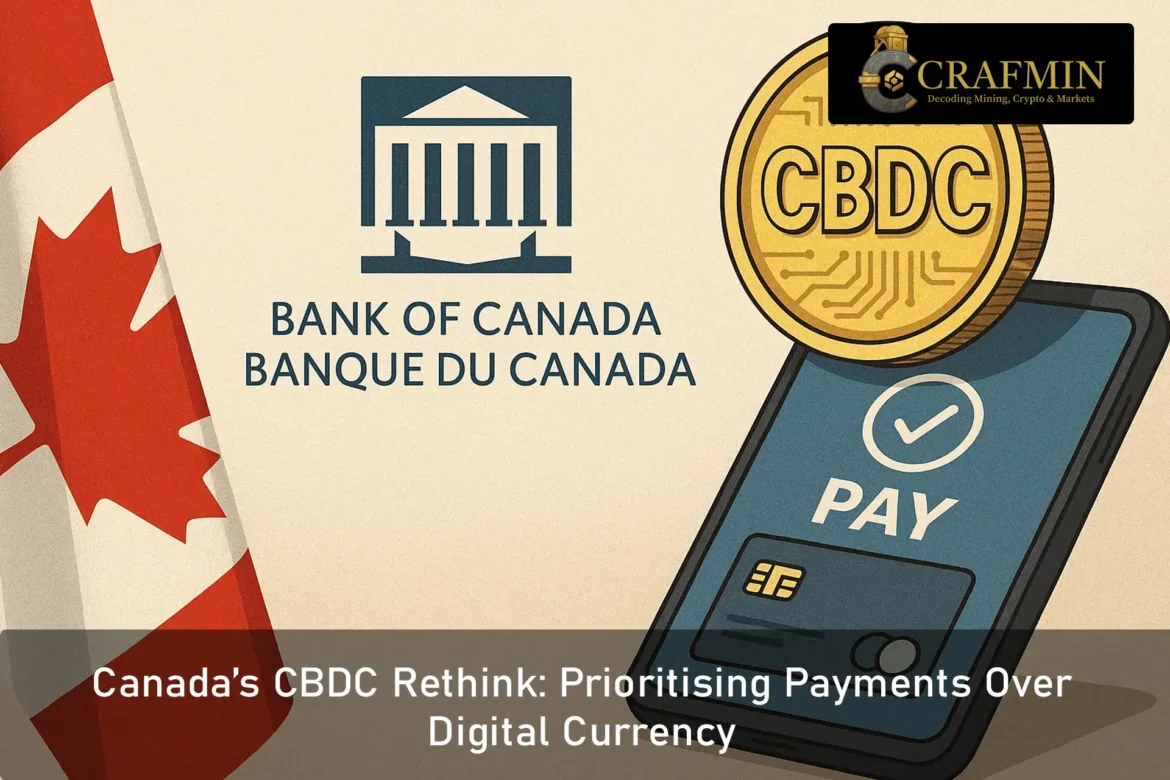The Digital Loonie Takes a Backseat
Canada is reassessing its CBDC plans, choosing a cautious pause over an accelerated rollout. Rather than launching a retail digital loonie, the Bank of Canada is shifting its focus to enhancing the nation’s digital payment systems.
This isn’t a step back. It’s a deliberate redirection.
Officials say there’s no immediate public demand for a retail central bank digital currency at this time. However, the central bank remains technically equipped to launch one if national priorities or public interest shift in future.

Canada’s CBDC Shift: Putting Payment Innovation Ahead of Digital Currency ( Image Source: Ledger Insights – blockchain for enterprise )
Why the Change in Direction?
Over the past few years, the Bank of Canada has been deeply exploring the potential of digital currency. Through technical trials, international collaboration — including with MIT — and wide-scale public consultation, the central bank explored areas like privacy, accessibility, and offline functionality.
But one thing became evident: most Canadians aren’t demanding a digital loonie. Feedback from public consultations highlighted scepticism, with many participants questioning its necessity. With contactless payments, credit cards, and mobile wallets already in daily use, the appetite for a new government-backed digital currency remains low.
Instead of pushing ahead for innovation’s sake, the Bank is now channelling resources into refining the systems that Canadians already rely on for their everyday transactions.
What’s Changing on the Ground
Here’s what this new direction means for Canadians and those in the global fintech and crypto sectors:
- Retail CBDC on pause: Active work on developing a digital loonie has been paused unless Parliament or a clear public push revives it.
- Priority on Payment Improvements: Attention is now on upgrading Canada’s digital payment infrastructure to ensure greater speed, security, and accessibility.
- Increased regulation: The Bank of Canada will assume a greater role in overseeing retail payment providers, boosting transparency and consumer protection.
This cautious, research-led approach reflects Canada’s traditionally careful posture toward financial innovation. While other nations sprint to pilot flashy CBDCs, Canada is ensuring that changes are meaningful, not merely headline-grabbing.
Important information about the Canada Disability Benefit (CDB)!
The Federal government has announced that applications for the CDB will open on June 20, 2025. For more information about what will be needed for the application and how you will be able to submit it, visit… pic.twitter.com/M3OADE5Zsj
— Plan Institute (@planinstitute) June 13, 2025
For Crypto Pros: A Calculated Play, Not a Step Back
To crypto insiders, this pivot might seem like Canada is falling behind — but that misses the point.
The Bank’s strategy underlines a core principle: innovation should address real-world issues, not simply showcase cutting-edge tech. In many ways, this move mirrors the crypto industry’s own evolving ethos — build responsibly, with purpose.
Canada isn’t retreating from digital finance. It remains actively involved in blockchain exploration, international policy discussions, and the advancement of fintech solutions. What’s changing is the timing and focus — a retail CBDC is now viewed as a “someday,” not a “must-have today.”
Also Read: Chainlink, Kinexys by J.P. Morgan, and Ondo Finance Complete Cross-Chain Asset Settlement Trial
For the Public: Tangible Changes You’ll Notice
The everyday Canadian might not be fussed about central bank digital currencies — and that’s precisely why the Bank’s new focus matters.
People want better, faster, more secure payment systems. That’s exactly what’s coming.
A key project underway is the Real-Time Rail (RTR) system, currently being developed by Payments Canada. Designed to enable instant payments between banks and platforms, RTR promises to enhance access for small businesses and underbanked groups.
In short, instead of reinventing the dollar, Canada is modernising how the dollar moves.
Why Privacy and Public Trust Matter
Public trust played a key role in Canada’s decision to pause the CBDC rollout.
Many Canadians voiced concern over surveillance, data privacy, and potential government overreach if a digital loonie were introduced. There were fears it could erode financial freedom or disproportionately impact vulnerable communities.
Add to that a sense of “tech fatigue” — after years of new digital systems, apps, and IDs — and the public appetite for yet another digital layer, especially one tied to the government, simply wasn’t there.
The message was clear: innovation must serve people, not unsettle them.
Bank in Canada refuses to allow a man to withdraw his money.
Now imagine one permissioned blockchain controlled by the central bank. A system that can track funds, suspend accounts and pause transactions.
That’s a CBDC. That’s the future they wantpic.twitter.com/CeUtmuA4dX
— Coin Bureau (@coinbureau) April 16, 2024
Eyes on the Global Landscape
Though Canada is slowing its CBDC efforts, it’s far from inactive. The Bank of Canada is carefully monitoring global movements — from China’s digital yuan pilots to Europe’s digital euro developments and America’s slow-paced digital dollar discussions.
Should conditions change — say, a decline in cash use or rising international demand for CBDCs — Canada is poised to act. The technological groundwork has already been laid to launch quickly if needed.
A People-First Path Forward
In an era where digital transformations often feel rushed, Canada is offering a refreshing counter-narrative — one grounded in patience, practicality, and public interest.
This isn’t about abandoning innovation. It’s about aligning it with real demand and meaningful impact.
So whether you’re a blockchain enthusiast or just someone who wants payments that are quicker, safer, and more inclusive, Canada’s pivot is designed with you in mind.
As for the digital loonie? It hasn’t been scrapped — just shelved. Ready for the right moment to return, when Canadians truly want and need it.

